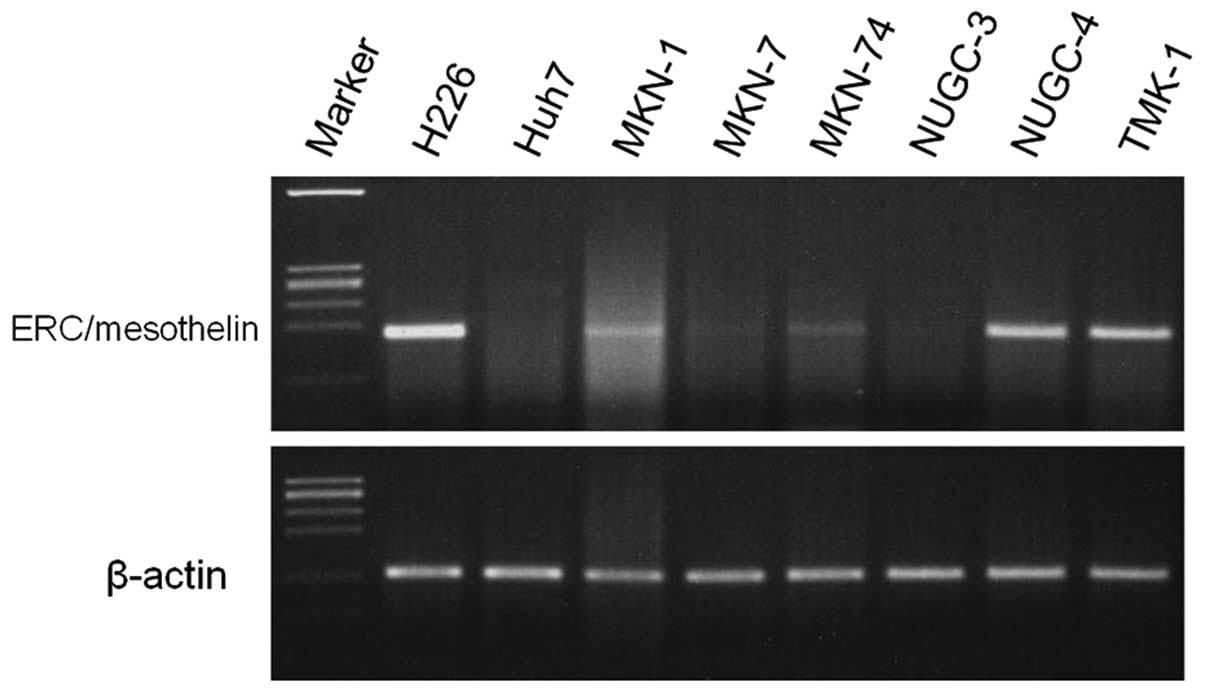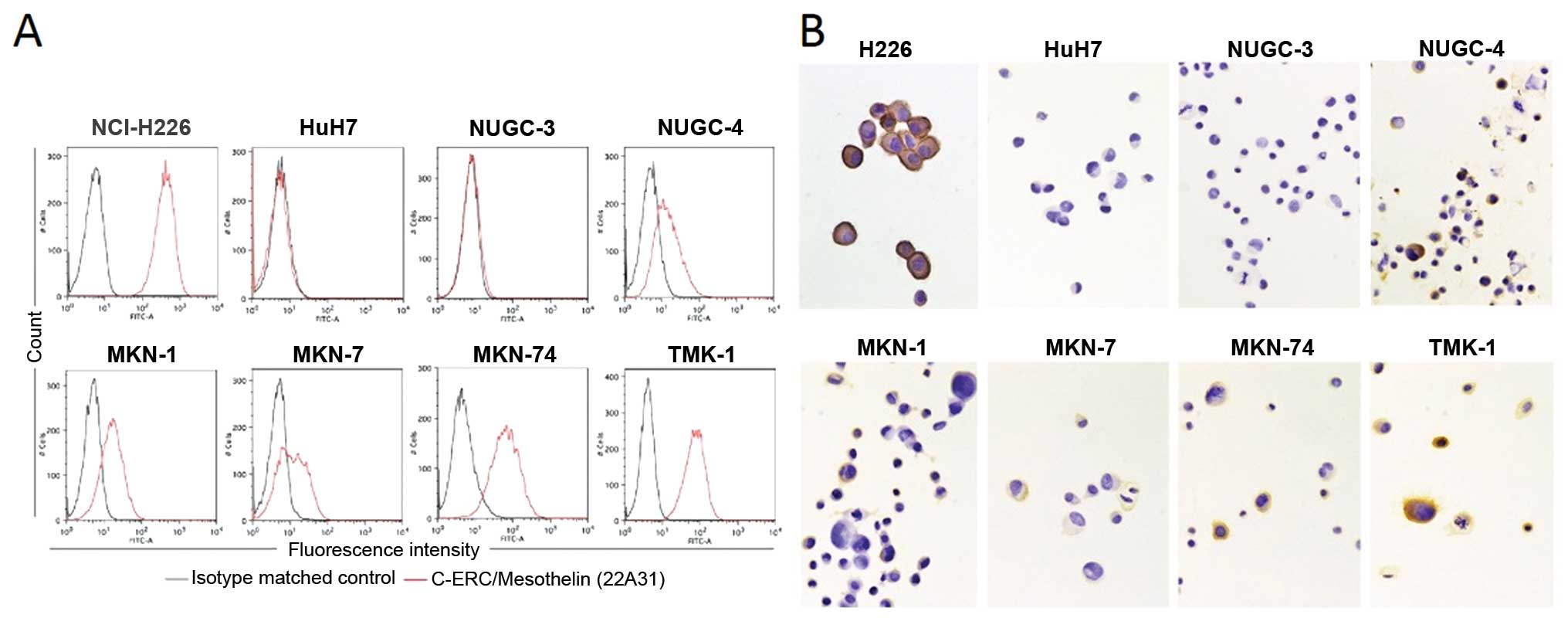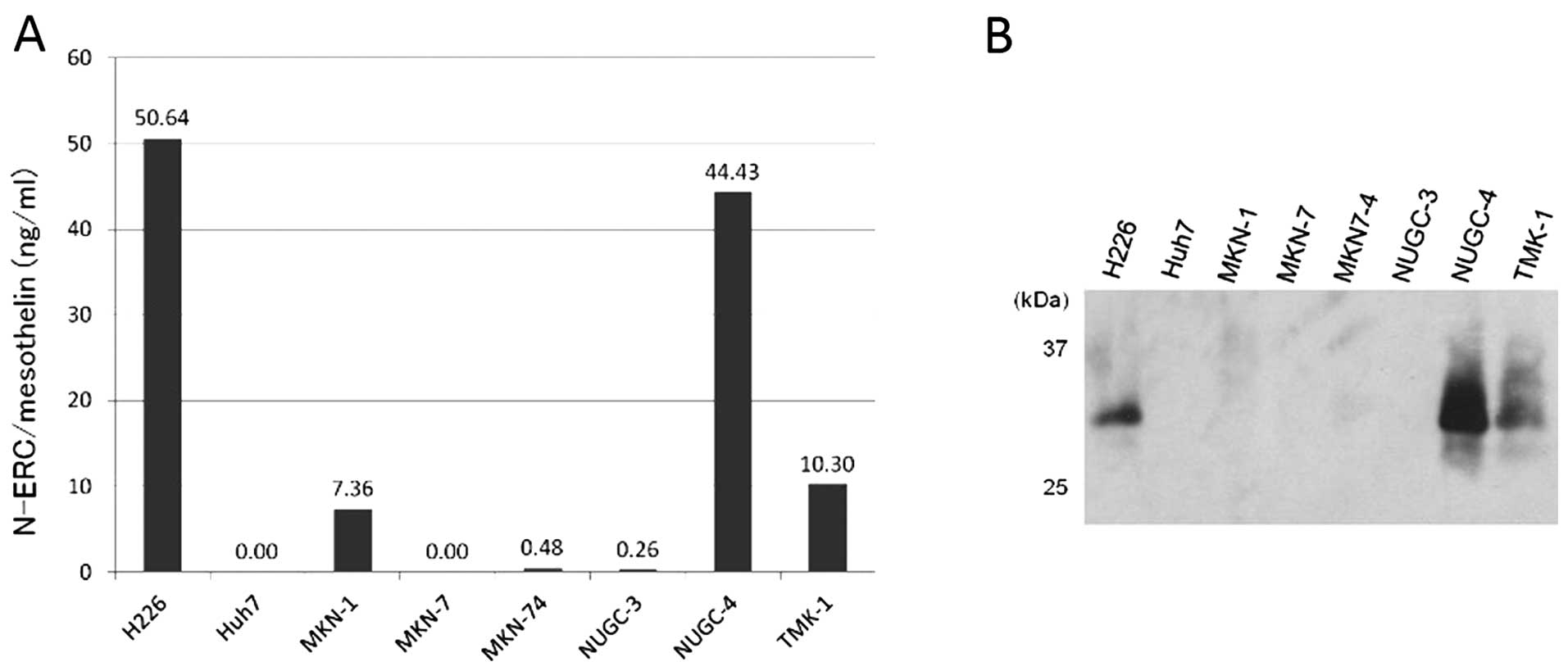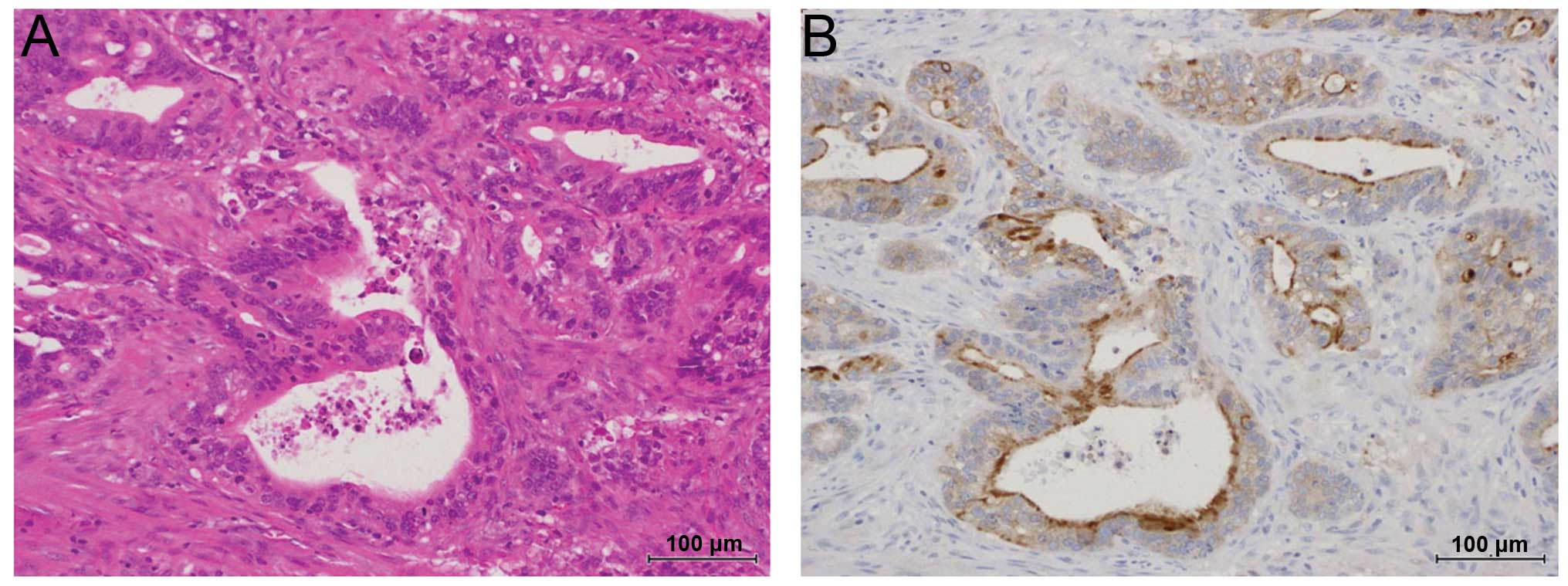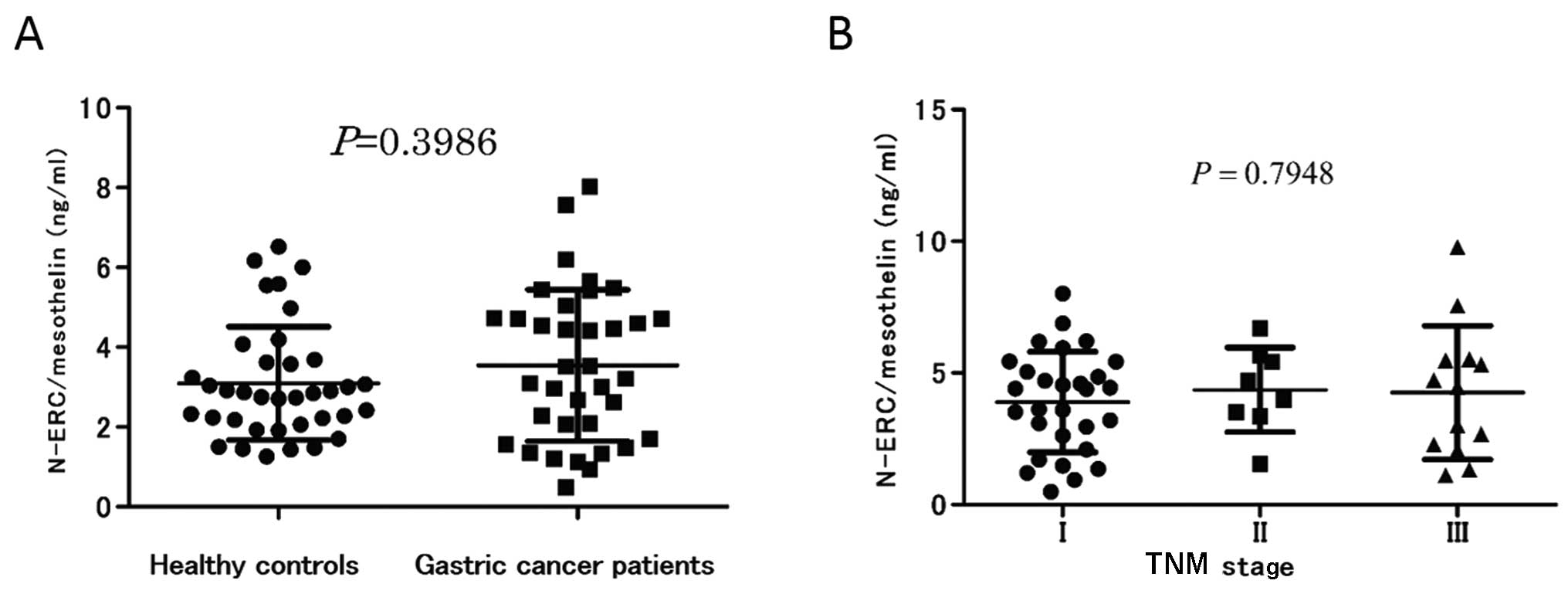Introduction
Previously, we found that the ERC (expressed
in renal carcinoma) gene was preferentially expressed in renal
cancers in the Eker rat (1).
Furthermore, we subsequently confirmed that ERC is a homolog of the
human mesothelin gene, a gene that is strongly expressed in normal
mesothelial cells, mesotheliomas, non-mucinous ovarian carcinomas
and pancreatic ductal adenocarcinomas (2,3). The
ERC/mesothelin gene (MSLN) encodes a 71-kDa precursor
protein, which is cleaved by proteases to yield 31-kDa N-terminal
(N-ERC/mesothelin) and 40-kDa C-terminal (C-ERC/mesothelin)
proteins (4,5). N-ERC/mesothelin [also known as
megakaryocyte-potentiating factor (MPF)] is a soluble protein and
is released into the extracellular space and blood (4–9).
C-ERC/mesothelin is a glycoprotein that is tethered to the cell
surface by a glycosyl-phosphatidylinositol anchor.
In addition to mesothelioma, C-ERC/mesothelin is
also expressed in ovarian cancer (4,10),
pancreatic ductal adenocarcinoma (8,11,12),
breast cancer (13), colorectal
cancer (14) and esophageal
adenocarcinoma (15). Several
studies have detected C-ERC/mesothelin in human gastric cancer by
immunohistochemical staining (16–18).
As for secreted N-ERC/mesothelin, we previously
devised a novel enzyme-linked immunosorbent assay (ELISA) system
for determining its concentration in serum and showed that it is
useful for diagnosing human mesothelioma (7,9,19).
However, its utility for diagnosing gastric cancer has not yet been
examined. Therefore, in the present study we evaluated the
expression and extracellular secretion of ERC/mesothelin in human
gastric cancer tissues and cell lines derived from gastric
cancer.
ELISA detected N-ERC/mesothelin in 3 of the 6
studied gastric cancer cell lines; however, its concentration in
the sera of gastric cancer patients was almost the same as that in
the sera of the normal controls. Therefore, N-ERC/mesothelin is not
useful as a diagnostic marker of gastric cancer. Conversely, in the
gastric cancer tissues, C-ERC/mesothelin expression was associated
with lymphatic invasion. This result agrees with the findings
reported by Einama et al(18).
Materials and methods
Cell lines
MKN-1 (adenosquamous carcinoma), MKN-7
(well-differentiated adenocarcinoma), MKN-74 (moderately
differentiated adenocarcinoma) and NUGC-4 (signet ring cell
carcinoma) cells, which are all derived from human gastric cancer,
and Huh7 cells, which lack endogenous ERC/mesothelin expression and
derived from human hepatocellular carcinoma, were provided by the
RIKEN BRC Cell Bank (Tsukuba-shi, Ibaraki, Japan). TMK-1 (poorly
differentiated adenocarcinoma) cells, which are derived from human
gastric cancer, were provided by Hiroshima University
(Hiroshima-shi, Hiroshima, Japan). NUGC-3 (poorly differentiated
adenocarcinoma) cells, which are derived from human gastric cancer,
were provided by the Health Science Research Resources Bank
(Sennan-shi, Osaka, Japan). NCI-H226 cells, which were used as a
positive-control and are derived from human mesothelioma, were
provided by the American Type Culture Collection (Manassas, VA,
USA). All of the cells, except the Huh7 cells, were cultured in
RPMI-1640 medium supplemented with 10% fetal calf serum (FCS). The
Huh7 cells were cultured in Dulbecco's modified Eagle's medium
(DMEM) supplemented with 10% FCS. The culture supernatants and
cells were harvested after being cultured for 48 h at 37°C under a
5% CO2 atmosphere, at which point they had reached
>80% confluence.
Reverse transcription-polymerase chain
reaction (RT-PCR)
The mRNA levels of ERC/mesothelin in the cultured
cells (MKN-1, MKN-7, MKN-74, NUGC-3, NUGC-4 and TMK-1) were
analyzed by RT-PCR. RT-PCR was carried out using the Titan RT-PCR
system (Roche Diagnostics GmbH, Mannheim, Germany) according to the
manufacturer's instructions. Cells in Petri dishes were lysed with
TRIzol reagent according to the acid guanidinium
thiocyanate-phenol-chloroform extraction method (20) (Invitrogen Life Technologies,
Carlsbad, CA, USA). Total RNA was extracted from these lysates
according to the manufacturer's instructions. Total RNA (1 μg) was
reverse transcribed for 30 min at 50°C and subjected to PCR
amplification. The primers used to amplify ERC/mesothelin mRNA were
as follows: sense, 5′-CAAGAAGTGGGAGCTGGAAG-3′ and antisense,
5′-GTCTCCAGGGACGTCACATT-3′. As a control for the RT-PCR, β-actin
mRNA was amplified using the following β-actin-specific primers:
sense, 5′-CCGCGAGAAG ATGACCCAGA-3′ and antisense, 5′-CAGGAGGAGCAATG
ATCTTG-3′. All primers were purchased from Operon (Tokyo, Japan).
After an initial denaturation step of 2 min at 94°C, each sample
was subjected to 30 cycles of amplification (denaturation, 30 sec
at 94°C; annealing, 30 sec at 55°C and elongation, 1 min at 68°C)
followed by a final elongation step of 2 min at 68°C. The PCR
products (20 μl) were analyzed on a 2% agarose gel containing 1
μg/ml ethidium bromide.
Flow cytometric analysis
Cell surface C-ERC/mesothelin expression was
analyzed by flow cytometry, as described previously (21). Briefly, 5×105 cells were
incubated for 30 min at 4°C with 1 μg/ml of the
C-ERC/mesothelin-specific mouse monoclonal antibody 22A31, as
described previously (21), or with
1 μg/ml of normal mouse IgG1κ diluted in 2% FCS (100 μl). After
being washed with 2% FCS in medium, the cells were resuspended in
100 μl of 2% FCS in medium containing 2 μg/ml of Alexa Fluor
488-conjugated goat anti-mouse IgG (Molecular Probes, Eugene, OR,
USA) to detect the primary antibodies, before being incubated at
4°C for 30 min. After being washed with phosphate-buffered saline
(PBS), the stained cells were analyzed with an LSRFortessa™ cell
analyzer (BD Biosciences, San Jose, CA, USA).
Antibodies and western blot analysis
The culture supernatants of the MKN-1, MKN-7,
MKN-74, NUGC-3, NUGC-4, and TMK-1 cells were harvested and adjusted
with a solution containing 2% sodium dodecyl sulfate (SDS), 10%
glycerol, 50 mM Tris-HCl (pH 6.8), and 100 mM dithiothreitol (DTT),
before being boiled for 3 min. The culture supernatants were then
electrophoresed on 10% Laemmli gels and transferred onto
nitrocellulose membranes. The membranes were then blocked in a
mixture of 1% skimmed milk and PBS supplemented with 0.1% Tween-20
(PBS-T) for 1 h at room temperature. Next, the membranes were
incubated with the N-ERC/mesothelin-specific mouse monoclonal
antibody (MoAb) 7E7, as described previously (7), or a rabbit anti-actin polyclonal
antibody (sc-1616-R) (Santa Cruz Biotechnology, Inc., Santa Cruz,
CA, USA; 1:500 dilution) in a mixture of PBS-T and 1% skimmed milk
for 1 h at room temperature. The goat anti-mouse or anti-rabbit Ig
secondary antibodies, which were conjugated with peroxidase
labeled-dextran polymers (EnVision K4001 or K4003; DakoCytomation,
Glostrup, Denmark) at a dilution of 1:50 in a mixture of PBS-T and
1% skimmed milk, were allowed to react with the membranes at room
temperature for 1 h. The ECL detection system (GE Healthcare,
Buckinghamshire, UK) was used to visualize ERC/mesothelin on the
membranes.
Human subjects
The present study included 50 patients with gastric
cancer (40 men and 10 women; age range, 33–89 years; mean age,
71.5) who were diagnosed and provided blood samples between January
2009 and September 2011 at Juntendo Shizuoka Hospital, Juntendo
University School of Medicine. All clinical diagnoses of gastric
cancer were confirmed by microscopic examinations of the material
obtained during surgery or endoscopic resection. The present study
was approved by the Institutional Review Board of Juntendo Shizuoka
Hospital, Juntendo University School of Medicine. All patients
provided informed consent. Blood samples were collected from each
patient before surgery or endoscopic resection. Thirty-seven
healthy controls (age range, 53–79 years; mean age, 66.8) were
sampled at random from a database, as described previously
(9).
Immunohistochemistry
Tissue sections (3 μm) were prepared from archival
formalin-fixed, paraffin-embedded specimens. After being
deparaffinized, the tissue sections were heated in target retrieval
solution (DakoCytomation) for antigen retrieval and were then
treated with 3% hydrogen peroxide. Non-specific binding sites were
blocked by incubating the samples with 5% normal goat serum in PBS
for 20 min at room temperature. Next, the sections were incubated
overnight with primary antibody solutions diluted in PBS-T at 4°C.
We used mouse monoclonal anti-human C-ERC/mesothelin antibody 22A31
(1:40 dilution) as the primary antibody and the EnVision+ system
labeled with horseradish peroxidase (HRP) polymers (DakoCytomation)
as the secondary antibody. Diaminobenzidine was used as the
peroxidase substrate. The C-ERC/mesothelin immunostaining was
analyzed using the scoring system described by Einama et
al(18). For the immunostained
slides, the proportion of stained cancer cells was scored as +1 for
1–10, +2 for >10–50 and +3 for >50%. The intensity of the
staining was scored as +1 for weak intensity and +2 for moderate to
strong intensity, and the location of the staining was also
recorded; i.e., in the luminal membrane or the cytoplasm. The final
evaluation of C-ERC/mesothelin expression was based on the
following scoring system: ‘positive-staining’ was defined as a
proportion score of ≥+3 and/or an intensity score of +2, while
‘negative staining’ was defined as a total score of <+3, except
in cases involving a proportion score of +1 and an intensity score
of +2.
Sandwich ELISA
The N-ERC/mesothelin concentrations in the patient
sera and the cell culture supernatants of the MKN-1, MKN-7, MKN-74,
NUGC-3, NUGC-4 and TMK-1 cells were analyzed using the sandwich
ELISA method (7), which was
performed as described previously (7,9) using
the 7E7 MoAb and the HRP-conjugated polyclonal antibody-282. The
absorbance of the solution was measured at 450 nm in an ELISA
reader (EMax; Molecular Devices, Sunnyvale, CA, USA).
Statistical analysis
The data were analyzed with GraphPad Prism 5.0
(GraphPad Software, San Diego, CA, USA). The measurement data were
analyzed using the Mann-Whitney and Kruskal-Wallis tests, while the
categorical data were analyzed using Fisher's exact test. P<0.05
was considered to indicate a statistically significant result.
Results
Expression of ERC/mesothelin mRNA in
human gastric cancer cell lines
In 5 of the 6 investigated gastric cancer cell lines
(MKN-1, MKN-7, MKN-74, NUGC-4 and TMK-1), ERC/mesothelin mRNA and
C-ERC protein were detected by RT-PCR (Fig. 1), flow cytometry (Fig. 2A) and immunohistochemistry (Fig. 2B). The C-ERC/mesothelin was
localized in the cytoplasm and/or on the cell membrane (Fig. 2). ELISA demonstrated that 3 of these
5 cell lines (MKN-1, NUGC-4 and TMK-1) excreted N-ERC into the
culture medium (Fig. 3A). However,
western blotting only detected N-ERC in the media from 2 cell lines
(NUGC-4 and TMK-1) (Fig. 3B).
C-ERC/mesothelin expression in human
gastric cancer
Immunohistochemically, positive C-ERC/mesothelin
staining was observed on the cancer cell membrane and in the
cytoplasm (Fig. 4). Among the 50
tumors examined, 29 (58%) were positive for C-ERC/mesothelin.
Luminal membrane expression of C-ERC/mesothelin was observed in 15
cases (30%).
Clinicopathological correlations
The correlations between the clinicopathological
features and C-ERC/mesothelin expression in the primary tumors are
summarized in Table I.
C-ERC/mesothelin positivity was not associated with any of the
parameters. However, the incidence of C-ERC/mesothelin luminal
membrane expression was correlated with lymphatic invasion
(P=0.0286).
 | Table IClinicopathological characteristics of
the gastric cancer patients according to C-ERC/mesothelin
staining. |
Table I
Clinicopathological characteristics of
the gastric cancer patients according to C-ERC/mesothelin
staining.
| C-ERC expression | | Luminal membrane
expression | |
|---|
|
| |
| |
|---|
| Parameter | Positive (n=29) | Negative (n=21) | P-value | Positive (n=15) | Negative (n=35) | P-value |
|---|
| Gender | | | 0.3145 | | | 0.3044 |
| Male | 24 | 14 | | 13 | 25 | |
| Female | 5 | 7 | | 2 | 10 | |
| Age, yearsa | 73.17±10.52 | 69.24±13.40 | 0.3757 | 72.27±12.20 | 71.2±11.87 | 0.8404 |
| Tumor size,
mma | 51.90±51.62 | 40.90±30.75 | 0.6021 | 48.87±29.30 | 46.60±49.38 | 0.433 |
| Histology | | | 0.1226 | | | 0.1764 |
| Well-moderate | 23 | 12 | | 13 | 22 | |
| Poor | 6 | 9 | | 2 | 13 | |
| T
classification | | | 0.569 | | | 0.5355 |
| 1 | 15 | 13 | | 7 | 21 | |
| 2–4 | 14 | 8 | | 8 | 14 | |
| N
classification | | | 1 | | | 0.5279 |
| 0 | 18 | 13 | | 8 | 23 | |
| 1–3 | 11 | 8 | | 7 | 12 | |
| Lymphatic
invasion | | | 0.0848 | | | 0.0286b |
| Positive | 19 | 8 | | 12 | 15 | |
| Negative | 10 | 13 | | 3 | 20 | |
| Venous
invasion | | | 0.7685 | | | 0.5279 |
| Positive | 12 | 7 | | 7 | 12 | |
| Negative | 17 | 14 | | 8 | 23 | |
| TNM stage | | | 0.7734 | | | 0.3557 |
| 1 | 16 | 13 | | 7 | 22 | |
| 2–4 | 13 | 8 | | 8 | 13 | |
Serum levels of N-ERC/mesothelin in the
gastric cancer patients
The N-ERC/mesothelin levels in the sera of the
patients were evaluated. We selected 38 of the 50 patients for
age-matching with the control group. The sera of the 38 age-matched
gastric cancer patients (26 men and 10 women, age range, 33–78
years; mean age, 65.0) were compared with those of the 37 healthy
controls (24 men and 13 women, age range, 53–79 years; mean age,
66.8) as described previously (9).
There was no significant difference between the serum
N-ERC/mesothelin concentrations of the cancer patients and healthy
controls (P=0.3986) (Fig. 5A). When
TNM stage was analyzed, a significant correlation with the serum
N-ERC/mesothelin concentration was not detected (P=0.7948)
(Fig. 5B).
Discussion
We evaluated the expression and extracellular
secretion of ERC/mesothelin in human gastric cancer cell lines. All
of the human gastric cancer cell lines, except NUGC-3, expressed
ERC/mesothelin mRNA and C-ERC/mesothelin protein. However, their
expression levels in the human gastric cancer cells were lower than
those noted in the H226 human mesothelioma cells (Figs. 1 and 2). The ERC/mesothelin mRNA levels detected
in the cultured cells were approximately correlated with the
expression level of C-ERC/mesothelin protein, suggesting that this
gene was mainly regulated at the transcriptional level.
ELISA (7,9) detected N-ERC/mesothelin in the
supernatants of 3 cell lines (MKN-1, NUGC-4 and TMK-1). The
N-ERC/mesothelin concentration in the culture medium roughly
reflected the mRNA levels detected in the cells (Figs. 1 and 3). Immunoblotting only detected secretory
N-ERC/mesothelin in 2 cell lines (NUGC-4 and TMK-1), indicating
that the ELISA was more sensitive than our immunoblotting technique
for detecting N-ERC/mesothelin.
As it was demonstrated that the gastric cancer cells
excrete N-ERC/mesothelin into the culture medium, we attempted to
detect it in the sera of the gastric cancer patients and explored
the possibility of using it as a diagnostic tool. First, we
compared the serum N-ERC/mesothelin levels of all 50 patients (age
range, 33–89 years, mean age, 71.5) with those of the 102 healthy
controls (age range, 30–79 years, mean age, 52.3), which were
selected from a database as described previously (9). As a result, we found that the 50
patients exhibited a significantly higher serum N-ERC/mesothelin
level than that in the control group (P<0.0001). However, when
we randomly selected 38 patients with gastric cancer and 37
age-matched healthy controls, there was no significant difference
between the mean serum N-ERC/mesothelin concentration of the cancer
patients and that of the healthy control group. The serum level of
N-ERC/mesothelin is reported to increase with age (9), and our initial analysis without
age-matching produced biased results since the gastric cancer
patients tended to be older than the healthy controls.
In the present study, the serum N-ERC/mesothelin
concentration was not found to be a useful diagnostic marker of
gastric cancer. Previously, we and others have shown that the serum
N-ERC/mesothelin level is useful for diagnosing human mesothelioma
and ovarian cancer (7,9,19,22,23).
Conversely, in a previous study we did not find any significant
difference in the serum concentration of N-ERC/mesothelin between
pancreatic ductal carcinoma patients and healthy controls (8). Sharon et al(24) also reported that neither the serum
concentration of mesothelin nor that of MPF was elevated in
patients with pancreatic or biliary cancer. At present, we cannot
explain why N-ERC/mesothelin is abundantly excreted into the serum
in some malignancies but not in others, despite the fact that
C-ERC/mesothelin is expressed in all of these malignancies.
Creaney et al(25) demonstrated that the mesothelin
levels in patients with malignant pleural mesothelioma were
strongly correlated with their tumor burdens. Gastric tumors are
usually smaller than mesotheliomas, and this difference in tumor
mass may explain why patients with mesothelioma exhibit increased
serum N-ERC/mesothelin levels, but gastric cancer patients do not.
It is also possible that the endogenous level of ERC/mesothelin
expression is higher in mesothelioma cells than in gastric cancer
cells, as shown in Figs. 1 and
2 (H226 mesothelioma cells vs.
other gastric cancer cells). Other factors such as protease
activity may also be responsible for the lower serum
N-ERC/mesothelin levels experienced in gastric cancer cases.
We also examined the expression of C-ERC/mesothelin
in cultured gastric cancer cell lines and human gastric cancer
tissues by immunohistochemical staining. In the present study,
C-ERC/mesothelin positivity was detected in 5 of 6 gastric cancer
cell lines (83.3%). In addition, C-ERC/mesothelin positivity was
observed in human gastric cancer tissues from 29 of the 50 cases
(58%). These results concur with those reported by Scholler et
al(16), Baba et
al(17) and Einama et
al(18). Two of these 3 studies
examined the clinicopathological features and C-ERC/mesothelin
expression in gastric cancer (17,18).
Baba et al(17) reported
that C-ERC/mesothelin expression appears to be correlated with
prolonged patient survival. Conversely, Einama et
al(18) reported that
mesothelin expression was not correlated with the overall survival
of gastric cancer patients. However, they argued that luminal
membrane C-ERC/mesothelin expression was associated with lymphatic
invasion and poor patient outcomes (18). In the present study,
C-ERC/mesothelin positivity was not associated with any parameters.
However, it was demonstrated that the incidence of C-ERC/mesothelin
luminal membrane expression was correlated with lymphatic invasion
(P=0.0286). This finding is consistent with the results reported by
Einama et al(18) and agrees
with previous studies that showed that ERC/mesothelin enhances cell
adhesion and invasion (4). In an
in vitro study, Kawamata et al(14) demonstrated that C-ERC/mesothelin
provokes the lymphatic invasion of colorectal adenocarcinoma
cells.
In conclusion, N-ERC/mesothelin was secreted into
the culture supernatants of gastric cancer cell lines; however,
increased serum N-ERC/mesothelin concentrations were not specific
to gastric cancer patients. Therefore, N-ERC/mesothelin does not
appear to be useful as a serum marker of gastric cancer. The
present study is small and requires further validation, and did not
include cases involving the peritoneal dissemination of cancer
cells. ERC/mesothelin is endogenously expressed in the peritoneal
mesothelium, and future studies should examine whether the serum
N-ERC/mesothelin level could be used as a marker of peritoneal
invasion by gastric cancer.
Acknowledgements
We would like to thank Naoko Aoki for her management
of the present study. The present study was supported by grants
from the Vehicle Racing Commemorative Foundation.
References
|
1
|
Hino O, Kobayashi E, Nishizawa M, et al:
Renal carcinogenesis in the Eker rat. J Cancer Res Clin Oncol.
121:602–605. 1995. View Article : Google Scholar : PubMed/NCBI
|
|
2
|
Yamashita Y, Yokoyama M, Kobayashi E,
Takai S and Hino O: Mapping and determination of the cDNA sequence
of the Erc gene preferentially expressed in renal cell
carcinoma in the Tsc2 gene mutant (Eker) rat model. Biochem
Biophys Res Commun. 275:134–140. 2000.PubMed/NCBI
|
|
3
|
Hino O: Multistep renal carcinogenesis in
the Eker (Tsc 2 gene mutant) rat model. Curr Mol Med. 4:807–811.
2004. View Article : Google Scholar : PubMed/NCBI
|
|
4
|
Chang K and Pastan I: Molecular cloning of
mesothelin, a differentiation antigen present on mesothelium,
mesotheliomas, and ovarian cancers. Proc Natl Acad Sci USA.
93:136–140. 1996. View Article : Google Scholar : PubMed/NCBI
|
|
5
|
Hassan R, Bera T and Pastan I: Mesothelin:
a new target for immunotherapy. Clin Cancer Res. 10:3937–3942.
2004. View Article : Google Scholar : PubMed/NCBI
|
|
6
|
Hassan R, Remaley AT, Sampson ML, et al:
Detection and quantitation of serum mesothelin, a tumor marker for
patients with mesothelioma and ovarian cancer. Clin Cancer Res.
12:447–453. 2006. View Article : Google Scholar : PubMed/NCBI
|
|
7
|
Shiomi K, Miyamoto H, Segawa T, et al:
Novel ELISA system for detection of N-ERC/mesothelin in the sera of
mesothelioma patients. Cancer Sci. 97:928–932. 2006. View Article : Google Scholar : PubMed/NCBI
|
|
8
|
Inami K, Kajino K, Abe M, et al: Secretion
of N-ERC/mesothelin and expression of C-ERC/mesothelin in human
pancreatic ductal carcinoma. Oncol Rep. 20:1375–1380.
2008.PubMed/NCBI
|
|
9
|
Shiomi K, Hagiwara Y, Sonoue K, et al:
Sensitive and specific new enzyme-linked immunosorbent assay for
N-ERC/mesothelin increases its potential as a useful serum tumor
marker for mesothelioma. Clin Cancer Res. 14:1431–1437. 2008.
View Article : Google Scholar : PubMed/NCBI
|
|
10
|
Yen MJ, Hsu CY, Mao TL, et al: Diffuse
mesothelin expression correlates with prolonged patient survival in
ovarian serous carcinoma. Clin Cancer Res. 12:827–831. 2006.
View Article : Google Scholar : PubMed/NCBI
|
|
11
|
Argani P, Iacobuzio-Donahue C, Ryu B, et
al: Mesothelin is overexpressed in the vast majority of ductal
adenocarcinomas of the pancreas: identification of a new pancreatic
cancer marker by serial analysis of gene expression (SAGE). Clin
Cancer Res. 7:3862–3868. 2001.PubMed/NCBI
|
|
12
|
Atmaca A, Pauligk C, Steinmetz K,
Altmannsberger HM, Jäger E and Al-Batran SE: Prognostic impact of
phosphorylated mitogen-activated protein kinase expression in
patients with metastatic gastric cancer. Oncology. 80:130–134.
2011. View Article : Google Scholar : PubMed/NCBI
|
|
13
|
Wang L, Niu Z, Zhang L, et al:
Clinicopathological significance of mesothelin expression in
invasive breast cancer. J Int Med Res. 40:909–916. 2012. View Article : Google Scholar : PubMed/NCBI
|
|
14
|
Kawamata F, Homma S, Kamachi H, et al:
C-ERC/mesothelin provokes lymphatic invasion of colorectal
adenocarcinoma. J Gastroenterol. Mar 20–2013.(Epub ahead of
print).
|
|
15
|
Alvarez H, Rojas PL, Yong KT, et al:
Mesothelin is a specific biomarker of invasive cancer in the
Barrett-associated adenocarcinoma progression model: translational
implications for diagnosis and therapy. Nanomedicine. 4:295–301.
2008. View Article : Google Scholar
|
|
16
|
Scholler N, Fu N, Yang Y, et al: Soluble
member(s) of the mesothelin/megakaryocyte potentiating factor
family are detectable in sera from patients with ovarian carcinoma.
Proc Natl Acad Sci USA. 96:11531–11536. 1999. View Article : Google Scholar
|
|
17
|
Baba K, Ishigami S, Arigami T, et al:
Mesothelin expression correlates with prolonged patient survival in
gastric cancer. J Surg Oncol. 105:195–199. 2012. View Article : Google Scholar : PubMed/NCBI
|
|
18
|
Einama T, Homma S, Kamachi H, et al:
Luminal membrane expression of mesothelin is a prominent poor
prognostic factor for gastric cancer. Br J Cancer. 107:137–142.
2012. View Article : Google Scholar : PubMed/NCBI
|
|
19
|
Hino O and Maeda M: Diagnostic tumor
marker of asbestos-related mesothelioma. Environ Health Prev Med.
13:71–74. 2008. View Article : Google Scholar : PubMed/NCBI
|
|
20
|
Chomczynski P and Sacchi N: Single-step
method of RNA isolation by acid guanidinium
thiocyanate-phenol-chloroform extraction. Anal Biochem.
162:156–159. 1987. View Article : Google Scholar : PubMed/NCBI
|
|
21
|
Ishikawa K, Segawa T, Hagiwara Y, Maeda M,
Abe M and Hino O: Establishment of novel mAb to human
ERC/mesothelin useful for study and diagnosis of
ERC/mesothelin-expressing cancers. Pathol Int. 59:161–166. 2009.
View Article : Google Scholar : PubMed/NCBI
|
|
22
|
Onda M, Nagata S, Ho M, et al:
Megakaryocyte potentiation factor cleaved from mesothelin precursor
is a useful tumor marker in the serum of patients with
mesothelioma. Clin Cancer Res. 12:4225–4231. 2006. View Article : Google Scholar : PubMed/NCBI
|
|
23
|
Saeki H, Hashizume A, Izumi H, et al: The
utility of serum N-ERC/mesothelin as a biomarker of ovarian
carcinoma. Oncol Lett. 4:637–641. 2012.PubMed/NCBI
|
|
24
|
Sharon E, Zhang J, Hollevoet K, et al:
Serum mesothelin and megakaryocyte potentiating factor in
pancreatic and biliary cancers. Clin Chem Lab Med. 50:721–725.
2012. View Article : Google Scholar : PubMed/NCBI
|
|
25
|
Creaney J, Francis RJ, Dick IM, et al:
Serum soluble mesothelin concentrations in malignant pleural
mesothelioma: relationship to tumor volume, clinical stage and
changes in tumor burden. Clin Cancer Res. 17:1181–1189. 2011.
|















